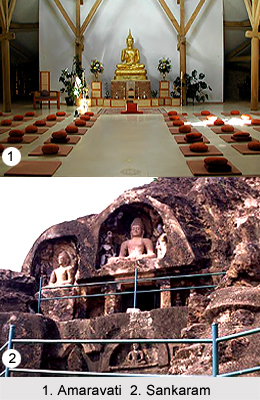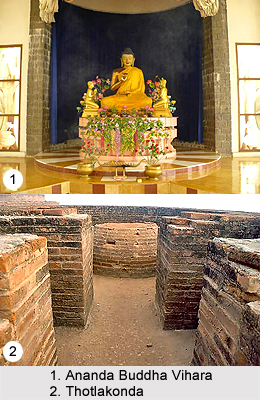 The state of Andhra Pradesh houses magnificent remains of many Buddhist Viharas and stupas. Tourists visiting the state can get a glorious glimpse of the ancient times when Buddhism flourished in the State. There are about 144 sites spread all over the state, which have withstood the ravages of time. It is from here that Buddhism was dispersed to the Far East including China, Japan and Sri Lanka. Few of the famous Buddhist Sites have been discussed below:
The state of Andhra Pradesh houses magnificent remains of many Buddhist Viharas and stupas. Tourists visiting the state can get a glorious glimpse of the ancient times when Buddhism flourished in the State. There are about 144 sites spread all over the state, which have withstood the ravages of time. It is from here that Buddhism was dispersed to the Far East including China, Japan and Sri Lanka. Few of the famous Buddhist Sites have been discussed below:
Nagarjuna Sagar
Nagarjuna Sagar is situated at a distance of 150 km from Hyderabad. It is regarded as one of the prominent Buddhist centres in Andhra Pradesh. During a hydro-electric project this Buddhist site was taken up for excavation. The structures were transplanted in a hill called Nagarjunakonda.
Nagarjunakonda
Nagarjunakonda is situated 150 km southeast of Hyderabad. It was one of the largest and most important Buddhist centres in South India from the second century BC until the third century AD. The site was named after Acharya Nagarjuna who was a renowned Buddhist scholar and philosopher. He had migrated here from Amarvati to propagate Lord Buddha`s message of universal peace and brotherhood. Excavations at this site have unearthed a university, monasteries, aswamedha altar, royal baths, advanced drainage system, viharas, chaityas, mandapams the life and times of the Buddha..
Amaravati
This is considered to be one of the oldest Buddhist site with the largest `stupa` in the country. Amaravati is located on the banks of the Krishna River, 35 km from the district headquarters city of Guntur and 60 km from the other major city of Vijayawada.
The place was originally known as `Dhanyakataka`.
Sankaram
Alexander Rea, a Britisher, unearthed Sankaram, a 2000-year-old Buddhist Heritage site in 1907. it is located 40 km from South of Vishakhapatnam. The three phases of Buddhism viz. Hinayana, Mahayana and Vajrayana flourished here. This complex is famous for its numerous Monolithic Votive Stupas, Rock cut caves and brick build structural edifices. Excavations yielded several historic potteries, Satavahana coins dating back to the 1st century A.D. several clay tablets bearing figures of Buddha etc
Bavikonda
Bavikonda is an important Buddhist heritage site located on a hill about 15kms, northeast from Visakhapatnam city. Here the Buddhist habitation is noticed on a 40 acres flat terraced area. Bavikonda in Telugu means a hill of wells. A Hinayana school of Buddhism was practiced here. Bavikonda Monastery flourished from 3rd Century B.C.and 3rd Century A.D.
Jagayyapeta
Jagayyapeta is a town located 40 km from the famous Amaravati on the opposite bank of the Krishna River. The site has a stupa positioned on a hill that can be dated back to the second century BC. The town is about 45 km from Vijayawada.
Bhattiprolu
Bhattiprolu is about 40 km from Guntur. A crystal casket with a Buddhist relic was found in the ruins of the Mahachaitya here. It now is enshrined at the Mahabodhi Society at Kolkata. The pre-Mauryan settlement here was known as Pratipalapura and the Mahachaitya here was almost 40 metres in diameter.
Chandavaram
 Chandavaram is located in Prakasam district and is 150 km from the city of Vijayawada. The place houses a double storied stupa located atop a hill.
Chandavaram is located in Prakasam district and is 150 km from the city of Vijayawada. The place houses a double storied stupa located atop a hill.
Ghantasala
Ghantasala is a village 60 km from the major city of Vijayawada. A cubic block made of bricks displays the 12 signs of the zodiac is found here. The dome of the stupa was adorned by 47 slabs depicting the Buddha.
Guntupalli
Guntupalli is located near Kamavarapukota in West Godavari district. It is regarded as one of the best Buddhist sites. Guntupalli is 85 km from Vijayawada city and the Buddhist site is located atop a hill. The beauty of the spot is enhanced by caves cut into the rocky portion of the hill, a circular Chaityagriha and several images of the Buddha.
Pavuralakonda
Pavuralakonda or `the hill of the pigeons` is a hillock lying to the west of Bhimli. It is about 24 km from Vizag. The Buddhist setllement found here is estimated to have witnessed human habitation from1st century BC to 2nd century AD. Sixteen rock cut cisterns for impounding rain water are found on the hillock, which offer a pleasant view of the coastline.
Ananda Buddha Vihara
Ananda Buddha Vihara is located in Mahendra Hills, Secunderabad. It is a non-profit public charitable Trust engaged in reviving and propagating Buddhist tradition and culture. The organisation consists of a Chaitya built in the ancient cave temple architecture, a museum and a library complex dedicated to Buddhist literature.
Thotlakonda
Thotlakonda Buddhist Complex is a famous hilltop monastery on the coast in the Indian state of Andhra Pradesh. The existence of Buddhist site at Thotlakonda came to light during an aerial survey undertaken by the Indian Navy. After its discovery, the Government of A.P has declared the site measuring an area of 120 acres on the summit as protected monument during 1978.
Gopalapatnam
Gopalapatnam is located on the left bank of River Tandava. It is village surrounded by stupas, viharas and other Buddhist remains. Ancient pottery was also excavated from these sites.
Ramatirtham
Ramatirtham is a village in Vizianagaram district of North Coastal Andhra. The remains of a Buddhist settlement dating to the first century AD were found here.
Salihundam
Salihundam is situated on the banks of the River Vamsadhara in Srikakulam District. The site consists of Vihara, Mahastupa and Ayakas. Srikakulam town is about 90 km north of Visakhapatnam.
Dantapuram
Dantapuram is located on the bank of the Vamsadhara River in Srikakulam district. The site is where a stupa was constructed to consecrate a tooth relic of the Buddha.
Dhulikatta
Dhulikatta is a village on the bank of a stream. This place is believed to have been one of the fortified towns mentioned by Megasthenes, the Greek ambassador in the court of Chandragupta Maurya in the third century BC. Coins and seals of Roman and Satavahana Dynasty were found among the remains of a Mahastupa.






